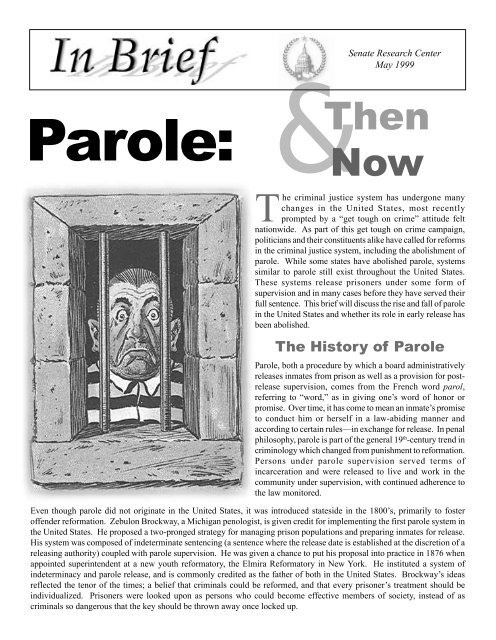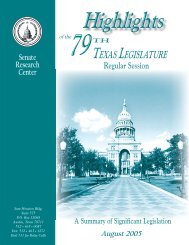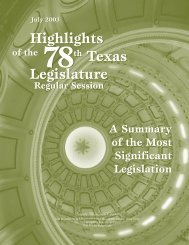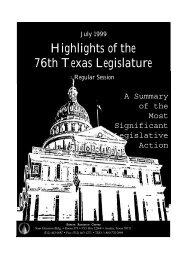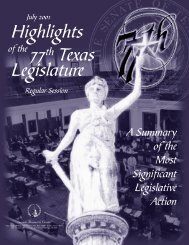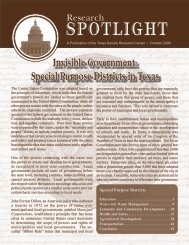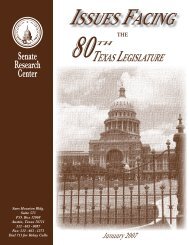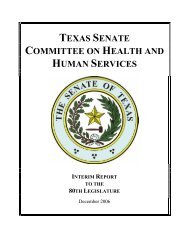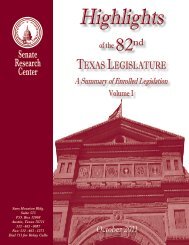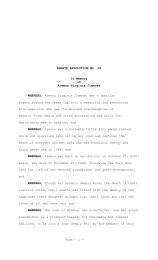Parole, Then and Now - Senate
Parole, Then and Now - Senate
Parole, Then and Now - Senate
Create successful ePaper yourself
Turn your PDF publications into a flip-book with our unique Google optimized e-Paper software.
<strong>Senate</strong> Research Center<br />
May 1999<br />
<strong>Parole</strong>:<br />
&<br />
<strong>Then</strong><br />
<strong>Now</strong><br />
The criminal justice system has undergone many<br />
changes in the United States, most recently<br />
prompted by a “get tough on crime” attitude felt<br />
nationwide. As part of this get tough on crime campaign,<br />
politicians <strong>and</strong> their constituents alike have called for reforms<br />
in the criminal justice system, including the abolishment of<br />
parole. While some states have abolished parole, systems<br />
similar to parole still exist throughout the United States.<br />
These systems release prisoners under some form of<br />
supervision <strong>and</strong> in many cases before they have served their<br />
full sentence. This brief will discuss the rise <strong>and</strong> fall of parole<br />
in the United States <strong>and</strong> whether its role in early release has<br />
been abolished.<br />
The History of <strong>Parole</strong><br />
<strong>Parole</strong>, both a procedure by which a board administratively<br />
releases inmates from prison as well as a provision for postrelease<br />
supervision, comes from the French word parol,<br />
referring to “word,” as in giving one’s word of honor or<br />
promise. Over time, it has come to mean an inmate’s promise<br />
to conduct him or herself in a law-abiding manner <strong>and</strong><br />
according to certain rules—in exchange for release. In penal<br />
philosophy, parole is part of the general 19 th -century trend in<br />
criminology which changed from punishment to reformation.<br />
Persons under parole supervision served terms of<br />
incarceration <strong>and</strong> were released to live <strong>and</strong> work in the<br />
community under supervision, with continued adherence to<br />
the law monitored.<br />
Even though parole did not originate in the United States, it was introduced stateside in the 1800’s, primarily to foster<br />
offender reformation. Zebulon Brockway, a Michigan penologist, is given credit for implementing the first parole system in<br />
the United States. He proposed a two-pronged strategy for managing prison populations <strong>and</strong> preparing inmates for release.<br />
His system was composed of indeterminate sentencing (a sentence where the release date is established at the discretion of a<br />
releasing authority) coupled with parole supervision. He was given a chance to put his proposal into practice in 1876 when<br />
appointed superintendent at a new youth reformatory, the Elmira Reformatory in New York. He instituted a system of<br />
indeterminacy <strong>and</strong> parole release, <strong>and</strong> is commonly credited as the father of both in the United States. Brockway’s ideas<br />
reflected the tenor of the times; a belief that criminals could be reformed, <strong>and</strong> that every prisoner’s treatment should be<br />
individualized. Prisoners were looked upon as persons who could become effective members of society, instead of as<br />
criminals so dangerous that the key should be thrown away once locked up.
<strong>Parole</strong>:<br />
&<br />
<strong>Then</strong><br />
<strong>Now</strong><br />
<strong>Parole</strong>:<br />
<strong>Then</strong> & <strong>Now</strong><br />
Useful Terms<br />
<strong>Parole</strong> - A procedure by which a board<br />
administratively releases inmates from<br />
prison as well as a provision for postrelease<br />
supervision.<br />
Discretionary <strong>Parole</strong> - Release of a<br />
person into the community because of<br />
a parole board decision.<br />
M<strong>and</strong>atory Release - The required<br />
release of inmates at the expiration of<br />
a certain time period. M<strong>and</strong>atory<br />
releases are persons whose release<br />
from prison was not decided by a<br />
parole board. Includes those entering<br />
because of determinate sentencing<br />
statutes, good-time provisions, or<br />
emergency releases.<br />
Expiration Release - Refers to the<br />
release of an inmate after serving his<br />
full sentence.<br />
<strong>Parole</strong> Supervision - Community<br />
supervision of an individual released<br />
from prison with a set of conditions<br />
for remaining on parole, which, if<br />
violated, can cause the person to be<br />
returned to prison. This subsequent<br />
incarceration can be for any of the<br />
remaining portion of the sentence the<br />
inmate may have on the current<br />
offense.<br />
Indeterminate Sentencing - A release<br />
date is established at the discretion of<br />
a releasing authority, such as a parole<br />
board.<br />
Determinate Sentencing - A release<br />
date is established at the time of<br />
sentencing.<br />
Post-Prison Supervision - When the<br />
inmate is released from prison into<br />
community supervision. Some postprison<br />
supervision has a set of<br />
conditions which, if violated, can<br />
cause the person to be returned to<br />
prison. Other post-prison supervision<br />
takes place after an inmate has served<br />
a full prison term <strong>and</strong> is then required<br />
to remain under supervision for a set<br />
period of time after being released.<br />
On being admitted to Elmira, each<br />
inmate (males between the ages of<br />
16 <strong>and</strong> 30) was placed in the second<br />
grade of classification. Six months of good<br />
conduct meant promotion to the first grade;<br />
however, misbehavior could result in being<br />
placed in the third grade. If an inmate was<br />
placed in the third grade, he would have to<br />
work his way back up. Continued good<br />
behavior in the first grade resulted in release.<br />
<strong>Parole</strong>d inmates remained under the<br />
jurisdiction of authorities for an additional<br />
six months, during which the parolee was<br />
required to report on the first day of every<br />
month to his appointed volunteer guardian<br />
(from which parole officers evolved) <strong>and</strong><br />
provide an account of his situation <strong>and</strong><br />
conduct. Written reports became required<br />
<strong>and</strong> were submitted to the institute after<br />
being signed by the parolee’s employer <strong>and</strong><br />
guardian.<br />
After Brockway’s introduction, parole <strong>and</strong><br />
indeterminate sentencing spread rapidly<br />
through the United States, <strong>and</strong> in 1907, New<br />
York became the first state to adopt all the<br />
components of a parole system:<br />
indeterminate sentences, a system for<br />
granting release, post release supervision,<br />
<strong>and</strong> specific criteria for parole revocation.<br />
By 1927, only Florida, Mississippi, <strong>and</strong><br />
Virginia were without parole systems. By<br />
1942, all states <strong>and</strong> the federal government<br />
had a parole system run by parole boards.<br />
These parole boards, usually political<br />
appointees, were given broad discretion to<br />
determine when an offender was ready for<br />
release, a decision limited only by the<br />
constraints of the maximum sentence<br />
imposed by the judge.<br />
<strong>Then</strong> with the growth of<br />
parole, it was used as a<br />
st<strong>and</strong>ard mode of release<br />
from prison, routinely 80%<br />
considered upon 70%<br />
completion of a<br />
60%<br />
minimum term of<br />
50%<br />
confinement. What had<br />
initially been used as a 40%<br />
special privilege to be 30%<br />
extended to exceptional<br />
20%<br />
prisoners, came to be<br />
10%<br />
used as a mechanism for<br />
controlling prison<br />
growth. <strong>Parole</strong> also<br />
developed a distinctly rehabilitative<br />
rationale, incorporating the promise of help<br />
<strong>and</strong> assistance as well as surveillance. By<br />
the mid-1950’s, indeterminate sentencing<br />
coupled with parole release was so well<br />
entrenched in the United States, it was the<br />
dominant sentencing structure in every state.<br />
In the early 1970’s, states followed an<br />
indeterminate sentencing model <strong>and</strong><br />
permitted parole boards to determine when<br />
an offender would be released from prison.<br />
In addition, good-time reductions for<br />
satisfactory prison behavior, earned-time<br />
incentives for participation in work or<br />
educational programs, <strong>and</strong> other time<br />
reductions in order to control prison<br />
crowding resulted in the early release of<br />
prisoners. These policies permitted officials<br />
to individualize the amount of punishment<br />
or leniency an offender received <strong>and</strong><br />
provided a means to manage the prison<br />
population. Indeterminate sentencing<br />
coupled with parole release was routine <strong>and</strong><br />
considered to be good correctional practice.<br />
The good intentions of the parole system had<br />
evolved to the extreme, <strong>and</strong> prisoners were<br />
being released early in record numbers. By<br />
the late 1970’s, more than 70 percent of all<br />
inmates released were a result of decisions<br />
made by a parole board. [See Figure 1] The<br />
percentage of United States prisoners<br />
released on parole had risen from 44 percent<br />
in 1940, to a high of 72 percent in 1977, <strong>and</strong><br />
led some states to question the very<br />
foundations of the practice of parole, which<br />
resulted in the number of prisoners released<br />
in this fashion declining. In the late 1970’s<br />
<strong>and</strong> early 1980’s, the discretion in sentencing<br />
policy ultimately led critics to argue that<br />
some offenders were punished more harshly<br />
Figure 1 - Percent fo State Prisoners Released by Various Methods<br />
Discretionary <strong>Parole</strong><br />
40%<br />
M<strong>and</strong>atory Releases<br />
28%<br />
Other Conditional Releases<br />
17%<br />
10%<br />
Expiration Releases<br />
0%<br />
'77 '79 '81 '83 '85 '87 '89 '91 '93 '95 '97<br />
Source: Bureau of Justice Statistics, National Prisoner Statistics, selected years.<br />
<strong>Senate</strong> Research Center 2 May 1999
<strong>Parole</strong>:<br />
&<br />
<strong>Then</strong><br />
<strong>Now</strong><br />
than others for similar offenses, <strong>and</strong> that<br />
overall sentencing <strong>and</strong> release laws were too<br />
soft on criminals. Locking criminals away<br />
for longer periods of time <strong>and</strong> “just deserts”<br />
replaced rehabilitation as the primary goal<br />
of American prisons. States began<br />
developing sentencing guidelines, enacting<br />
m<strong>and</strong>atory minimum sentences, <strong>and</strong><br />
adopting other sentencing reforms in<br />
attempts to reduce disparity in sentencing<br />
<strong>and</strong> toughen penalties for certain offenses.<br />
Drug offenses, offenses with weapons, <strong>and</strong><br />
offenses committed by repeat or habitual<br />
criminals were specifically targeted by these<br />
new penologists in an effort to reduce<br />
disparity <strong>and</strong> increase time served in prison.<br />
The pillars of the American corrections<br />
system—indeterminate sentencing coupled<br />
with parole release for the purpose of<br />
offender rehabilitation—in place for the<br />
majority of the twentieth century, basically<br />
collapsed during this time.<br />
By 1997, the 28 percent of state prisoners<br />
released as a result of parole board decisions<br />
was the lowest figure since the federal<br />
government began compiling statistics on<br />
the issue. This compares to 41 percent of<br />
state prisoners released as a result of a parole<br />
board decision in 1990. M<strong>and</strong>atory releases,<br />
where the required release of an inmate<br />
occurs at the expiration of a certain time<br />
period not decided by a parole board, now<br />
surpass parole releases, <strong>and</strong> if one adds<br />
expiration releases, there is an even bigger<br />
imbalance between discretionary parole <strong>and</strong><br />
m<strong>and</strong>atory release (28 percent v. 57 percent).<br />
These numbers reflect an obvious societal<br />
change in the perception of how prisoners<br />
should be h<strong>and</strong>led <strong>and</strong> whether punishment<br />
or reformation is more important.<br />
Abolishment<br />
of <strong>Parole</strong><br />
One of the arguments for eliminating parole,<br />
or limiting its use, is to increase the length<br />
of prison term served. In 1975, Maine<br />
became the first state to adopt this point of<br />
view <strong>and</strong> eliminate parole. The following<br />
year, California <strong>and</strong> Indiana joined Maine<br />
in establishing determinate sentencing<br />
legislation (the release date is established at<br />
the time of the sentence) <strong>and</strong> abolishing<br />
discretionary parole release (persons<br />
entering the community because of a parole<br />
board decision). Additionally, Colorado<br />
abolished discretionary parole release in<br />
1979. North Carolina placed severe<br />
constraints on its parole commission in 1981,<br />
<strong>and</strong> by adopting sentencing guidelines in<br />
1983, Florida also abolished parole. This<br />
movement towards abolishing parole was<br />
the first in a series of reforms that would<br />
change the face of the corrections system<br />
throughout the United States. After all,<br />
parole <strong>and</strong> indeterminate sentencing had<br />
been around since the late 19 th century, <strong>and</strong><br />
people could only hypothesize about the<br />
abolishment of parole <strong>and</strong> its actual effects.<br />
After this initial movement by states to<br />
abolish parole, some retreated. North<br />
Carolina, Florida, <strong>and</strong> Colorado have since<br />
re-established its equivalent. North Carolina<br />
has gradually restored some of its previous<br />
discretion in the practice of allowing<br />
prisoners to re-enter society. Florida has<br />
now returned the function under another<br />
name, <strong>and</strong> Colorado reinstated discretionary<br />
parole six years later. Apparently, these<br />
states felt that abolishment of parole was not<br />
necessarily the best way to h<strong>and</strong>le the<br />
problems associated with their correctional<br />
systems.<br />
Figure . Status of <strong>Parole</strong> <strong>and</strong> VOITIS TruthinSentencing Funds in the U.S.<br />
✖<br />
WA<br />
✖ (1989)<br />
OR<br />
CA<br />
◗<br />
(1984)<br />
●<br />
NV<br />
Alaska ◗<br />
●<br />
ID<br />
●<br />
UT<br />
AZ<br />
✖<br />
(1994)<br />
●<br />
MT<br />
Hawaii ◗<br />
●<br />
WY<br />
●<br />
CO<br />
✖<br />
(1979)<br />
NM<br />
Source: Status Report on <strong>Parole</strong>, 1996, Results from an<br />
NIC Survey (1997), <strong>and</strong> updated with information from<br />
Ditton <strong>and</strong> Wilson, 1999<br />
● VT<br />
● ✖<br />
ND (1980)<br />
MN<br />
WV<br />
◗<br />
◗<br />
SD ◗<br />
WI<br />
◗<br />
NY<br />
❉ MI<br />
●<br />
IA<br />
PA<br />
NE ◗ ◗ ✖ ✖ ✖<br />
(1996)<br />
(1978) (1977)<br />
IL IN OH ✖<br />
KS MO<br />
●<br />
◗<br />
(1995)<br />
✖ (1993)<br />
(1994)<br />
◗<br />
✖<br />
NC<br />
●<br />
◗<br />
OK<br />
●<br />
AR ● SC<br />
✖<br />
◗ (1995)<br />
AL GA<br />
MS ◗<br />
TX ◗ LA ◗<br />
FL<br />
◗<br />
●<br />
◗<br />
✖<br />
❉<br />
TN<br />
KY<br />
VA<br />
ME ✖<br />
NH ◗<br />
MA ◗<br />
RI ●<br />
CT ◗<br />
NJ ●<br />
DE ✖<br />
MD ◗<br />
DC<br />
The states <strong>and</strong> the Districts of Columbia that met<br />
the federal st<strong>and</strong>ards for Truth-in-Sentencing in 1998.<br />
<strong>Parole</strong> board has full release powers<br />
<strong>Parole</strong> board has limited release powers<br />
Discretionary <strong>Parole</strong> abolished (Year Abolished)<br />
Abolished discretionary parole release in 1999<br />
to go into effect on January, 1, 2000 for crimes<br />
committed on or after that date.<br />
(1975)<br />
(1990)<br />
If <strong>Parole</strong> Board Powers are<br />
State Limited, Crimes Ineligible for<br />
Discretionary Release<br />
California Only for indeterminate life sentence<br />
Connecticut Murders, capital felonies<br />
Florida Certain capital/life felonies<br />
Georgia Several felonies<br />
Hawaii Punishment by life w/o parole<br />
Iowa Murder 1, kidnap, sex abuse<br />
Louisiana Several felonies<br />
Maryl<strong>and</strong> Violent, or death penalty sought<br />
Massachusetts Murder 1<br />
Michigan Murder 1, 650+ g. cocaine<br />
Missouri Several felonies<br />
Nebraska Murder 1/life, kidnap/life<br />
New Hampshire Murder 1<br />
New York Violent felony offenders<br />
South Dakota None with life sentence<br />
Tennessee Murder1/life, rapes<br />
Texas None of death row<br />
West Virginia No life without mercy<br />
Wisconsin No life without parole<br />
<strong>Senate</strong> Research Center 3 May 1999
<strong>Parole</strong>:<br />
&<br />
<strong>Then</strong><br />
<strong>Now</strong><br />
By the end of 1999, 14 states had abolished<br />
discretionary parole for all offenders, <strong>and</strong><br />
21 others had severely limited its use. [See<br />
Figure 2, page 3] Of the 14 states that<br />
abolished discretionary parole, eight states<br />
abolished discretionary parole within the last<br />
10 years. However, the number of states that<br />
have abolished discretionary parole can be<br />
misleading if the difference between<br />
discretionary parole <strong>and</strong> parole is not<br />
understood. The abolishment of<br />
discretionary parole takes the release<br />
decision away from the parole board, <strong>and</strong><br />
some of the states that have abolished<br />
discretionary parole have other systems<br />
similar to parole in place. For example,<br />
some states provide that a prisoner serve a<br />
set amount of time in prison <strong>and</strong> then be<br />
released automatically into the community<br />
under supervision. This system releases a<br />
prisoner to the community with a set of<br />
conditions, which if violated, could cause<br />
the person to be returned to prison to serve<br />
out the remainder of their prison sentence.<br />
This system is similar to parole in that a<br />
prisoner is released before the entire<br />
sentence is served, but a parole board is not<br />
involved in determining when the release<br />
should occur.<br />
Although some states have abolished<br />
discretionary parole, 15 states have given<br />
their parole boards full authority to release<br />
inmates through a discretionary process,<br />
with other parole boards exercising<br />
discretionary control over inmates who were<br />
sentenced for crimes committed prior to the<br />
effective date of the law that eliminated<br />
parole board release. In 21 states, parole<br />
authorities operate under what might be<br />
called a sunset provision, still using this<br />
discretionary control over a small or<br />
diminished parole-eligible population.<br />
However, in those states that have retained<br />
parole as a means of releasing prisoners,<br />
granting parole has become much more<br />
stringent. In Texas over half, or 57 percent<br />
of all cases considered for parole release in<br />
1988, were approved. However, that figure<br />
dropped in 1998 to just 20 percent. In<br />
general, states restrict the possibility of<br />
parole board release based on the offenders’<br />
criminal history or the circumstances of the<br />
offense; <strong>and</strong> m<strong>and</strong>atory minimum<br />
sentencing policies now exist in every state.<br />
In the 15 states that give parole authorities<br />
the discretionary power to release prisoners,<br />
most of them utilize formal risk prediction<br />
instruments or parole guidelines to assist in<br />
the parole decision making. <strong>Parole</strong><br />
guidelines are usually actuarial devices,<br />
which objectively predict the risk of<br />
recidivism based on crime <strong>and</strong> offender<br />
background information. The guidelines<br />
produce a score for each individual by<br />
summing up points assigned for various<br />
background characteristics. Inmates with<br />
the least serious criminal history <strong>and</strong> the<br />
lowest statistical probability of re-offending<br />
would then be the first to be released. This<br />
use of objective instruments helps to reduce<br />
the disparity in parole decision making, <strong>and</strong><br />
has been shown to be more accurate than<br />
release decisions based on those which<br />
utilize case studies or individualized<br />
methods in their determinations.<br />
As has been noted, abolishment of parole<br />
was a target early on as<br />
a way to increase<br />
sentences <strong>and</strong> lock<br />
prisoners away<br />
longer. Since the<br />
1970’s, parole<br />
has been<br />
abolished in<br />
some states <strong>and</strong><br />
limited in others.<br />
Despite these<br />
developments,<br />
parole <strong>and</strong> similar<br />
systems are still<br />
in use throughout<br />
the United States,<br />
but the way<br />
parole is used has<br />
changed.<br />
Post-Prison<br />
Supervision<br />
As discussed earlier, some states have<br />
programs similar to parole. Today, 48 states<br />
<strong>and</strong> the federal system have some<br />
requirements for post-prison or parole<br />
supervision, with Maine <strong>and</strong> Virginia being<br />
the exceptions. At the federal level, the<br />
Comprehensive Crime Control Act of 1984<br />
created the United States Sentencing<br />
Commission. That legislation abolished the<br />
United States <strong>Parole</strong> Commission, <strong>and</strong><br />
parole was phased out from the federal<br />
criminal justice system in 1997. Offenders<br />
sentenced to federal prison are no longer<br />
eligible for parole release, but they are<br />
required to serve a defined term of<br />
“supervised release” following release from<br />
prison. That means a person serves a set<br />
number of years in prison <strong>and</strong> a set amount<br />
of time supervised in the community, all of<br />
which are pre-determined by a court.<br />
In Maine <strong>and</strong> Virginia, both the parole board<br />
<strong>and</strong> parole supervision have been abolished.<br />
In Virginia, the judge must remember to<br />
impose a split sentence with a term of<br />
probation, to follow prison, in order to have<br />
control of released prisoners. A few other<br />
states have also considered abolishing postprison<br />
or parole supervision, but the<br />
transition from prison back into the<br />
community is exceedingly difficult,<br />
with recidivism rates highest in<br />
the first year following release.<br />
Some figures put the number<br />
at fully half of all parolees<br />
failing to successfully<br />
complete parole, <strong>and</strong> their<br />
returns to prison represent<br />
about a third of all<br />
incoming United States<br />
prisoners each year. To assist<br />
in this high-risk time period,<br />
post-prison or parole<br />
supervision has historically<br />
provided job assistance,<br />
family counseling, <strong>and</strong><br />
chemical dependency<br />
programs.<br />
In 1997, nearly 80 percent of all released<br />
prisoners were subject to some form of postprison<br />
or parole supervision. While<br />
discretionary release from prison by a parole<br />
board has been eliminated by some states,<br />
some form of post-prison supervision still<br />
exists. To distance themselves from the<br />
negative image that parole has, some states<br />
changed the name. For example, post-prison<br />
supervision is called, variously among the<br />
states, controlled release authority in Florida,<br />
community control in Ohio, supervised<br />
release in Minnesota <strong>and</strong> in the federal<br />
system, <strong>and</strong> community custody in<br />
<strong>Senate</strong> Research Center 4 May 1999
<strong>Parole</strong>:<br />
&<br />
<strong>Then</strong><br />
<strong>Now</strong><br />
Washington. In some of the states that have<br />
abolished discretionary parole <strong>and</strong><br />
established determinate sentencing, a<br />
defendant could receive a sentence for a set<br />
amount of time <strong>and</strong> upon completion of a<br />
percentage of the sentence, say 85 percent,<br />
be released automatically without the<br />
discretion of a parole board to serve the<br />
remaining 15 percent of the sentence under<br />
supervision in the community, barring<br />
violation of the terms of release. <strong>Parole</strong><br />
boards, in various forms, have the<br />
responsibility to set conditions of release for<br />
offenders under conditional community or<br />
supervised release, the authority to return an<br />
offender to prison for violating the<br />
conditions of parole or supervised release,<br />
<strong>and</strong> the power to grant parole for medical<br />
reasons. Consequently, parole is not dead,<br />
rather it has taken on a new identity.<br />
Truth-In-<br />
Sentencing<br />
Truth-in sentencing is a new movement,<br />
started when parole was called into question.<br />
People reacted negatively to prisoners being<br />
released early <strong>and</strong> called for stronger<br />
sentences <strong>and</strong> requirements that inmates<br />
serve more of the sentence actually imposed<br />
by the courts. As a result of this public<br />
outcry, states <strong>and</strong> the federal government<br />
responded with various laws to combat the<br />
problem of early release. These new laws<br />
took on the moniker, truth-in-sentencing.<br />
Generally, truth-in-sentencing measures<br />
address the criminal sentence imposed by<br />
the court <strong>and</strong> the actual time an offender<br />
serves in prison. These truth-in-sentencing<br />
laws require offenders to serve a substantial<br />
portion of their prison sentence imposed by<br />
the court before being eligible for release,<br />
but the definition of truth-in-sentencing<br />
varies among the states, as does the<br />
percentage of sentence required to be served<br />
<strong>and</strong> the crimes covered by the laws. [See<br />
Figure 3] Some states include all crimes in<br />
their truth-in-sentencing legislation, <strong>and</strong><br />
most states target violent offenders under<br />
truth-in-sentencing. The percentage of<br />
sentence required to be served under truthin-sentencing,<br />
in general, spans from 50<br />
percent to 100 percent of a minimum<br />
sentence. Florida, Mississippi, <strong>and</strong> Ohio<br />
require all offenders to serve a substantial<br />
portion of their sentences before release.<br />
Indiana, Maryl<strong>and</strong>, Nebraska, <strong>and</strong> Texas<br />
have a 50 percent requirement. Idaho,<br />
Nevada, <strong>and</strong> New Hampshire require 100<br />
percent of sentence to be served.<br />
Moreover, Arizona adopted truth-insentencing<br />
in 1993, while undertaking a<br />
complete revamping of its criminal code.<br />
The law established the requirement that all<br />
inmates serve 85 percent of their sentences,<br />
followed by supervision in the community<br />
for the remaining 15 percent. California<br />
adopted truth-in-sentencing legislation in<br />
1994 <strong>and</strong> limited work credits that violent<br />
offenders can earn so that they must, by law,<br />
serve at least 85 percent of their sentence.<br />
Florida repealed sentencing guidelines in<br />
favor of minimum sentences, no parole for<br />
persistent offenders, <strong>and</strong> an 85 percent<br />
policy for others. Ohio reclassified all felony<br />
offenses <strong>and</strong> addressed truth-in-sentencing<br />
by eliminating discretionary parole release.<br />
Oklahoma enacted a major truth-insentencing<br />
act that requires violent offenders<br />
to serve 85 percent of the sentence, while<br />
other less serious offenders serve less time<br />
Figure 3. Truth-in-sentencing requirements, by State<br />
50% 100% of minimum Other<br />
Meet Federal 85% requirement requirement requirement requirements<br />
Arizona Missouri Indiana Idaho Alaska c<br />
California New Jersey Maryl<strong>and</strong> Nevada Arkansas d<br />
Connecticut New York Nebraska New Hampshire Colorado e<br />
Delaware North Carolina Texas Kentucky f<br />
District of Col. North Dakota Massachusetts g<br />
Florida Ohio Wisconsin h<br />
Georgia Oklahoma b<br />
Illinois a<br />
a<br />
Oregon<br />
Qualified for Federal funding in1996 only.<br />
b<br />
Iowa<br />
Pennsylvania Effective July 1, 1999, offenders will be required to serve 85% of the sentence.<br />
c Two-part sentence structure (2/3 in prison; 1/3 on parole); 100% of prison term required<br />
Kansas South Carolina d M<strong>and</strong>atory 70% of sentence for certain violent offenses <strong>and</strong> manufacture of methamphetamine.<br />
e<br />
Louisiana Tennessee Violent offenders with 2 prior violent convictions serve 75%; 1 prior violent conviction, 56.25%.<br />
f<br />
Maine Utah<br />
EffectiveJuly 15, 1998, offenders are required to serve 85% of the sentence.<br />
g Requires 75% of a minimum prison sentence.<br />
Michigan Virginia<br />
h Effective December 31, 1999, two-part sentence: offenders serve 100% of the prison term <strong>and</strong><br />
Minnesota Washington a sentence of extended supervision at 25% of the prison sentence.<br />
Mississippi<br />
Source: BJS Special Report: Truth-in-Sentencing in State Prisons<br />
<strong>Senate</strong> Research Center 5 May 1999
<strong>Parole</strong>:<br />
&<br />
<strong>Then</strong><br />
<strong>Now</strong><br />
or are h<strong>and</strong>led in the community corrections<br />
program. These examples illustrate how<br />
states have moved towards increasing time<br />
served in prison for serious or violent<br />
offenders. Some of the changes occurred<br />
before federal funding was approved, <strong>and</strong><br />
others were a direct result of the federal<br />
government influence.<br />
As a means of influencing the states,<br />
Congress addressed truth-in-sentencing in<br />
1994 as part of the Violent Crime Control<br />
<strong>and</strong> Law Enforcement Act that was<br />
subsequently amended in 1996. This<br />
legislation authorized funding at $8 billion,<br />
through the year 2000, for the Violent<br />
Offender Incarceration <strong>and</strong> Truth-in-<br />
Sentencing grant (VOITIS) program.<br />
VOITIS authorized the federal government<br />
to provide financial assistance to the 50<br />
states, the District of Columbia, <strong>and</strong> the<br />
United States territories, to construct or<br />
renovate prisons to incarcerate additional<br />
violent offenders. Those states <strong>and</strong><br />
territories that demonstrated that truth-insentencing<br />
<strong>and</strong> related incarceration policies<br />
existed for violent offenders became eligible<br />
for an increased portion of federal funding.<br />
Since fiscal year 1996, the Justice<br />
Department has provided more than $3.8<br />
billion through the VOITIS incentive grants<br />
program.<br />
The federal regulations were designed to<br />
accommodate various sentencing structures,<br />
including guidelines, as well as new laws<br />
that specified 85 percent of sentence policy.<br />
To qualify for truth-in-sentencing grants,<br />
states must require persons convicted of<br />
certain serious or violent offenses to serve<br />
not less than 85 percent of the prison<br />
sentence. To satisfy the 85 percent of<br />
sentence test <strong>and</strong> qualify for federal funds<br />
for prison construction, states have limited<br />
the powers of parole boards to set release<br />
dates, or of prison managers to award good<br />
time <strong>and</strong> gain time (time off for good<br />
behavior or participation in work or<br />
treatment programs), or both. The federal<br />
government’s financial assistance is spurring<br />
states to meet certain truth-in-sentencing<br />
guidelines <strong>and</strong> in the process, accommodate<br />
the public’s desire that more serious or<br />
violent offenders serve longer terms in<br />
prison. By the end of 1998, 27 states <strong>and</strong><br />
the District of Columbia required violent<br />
offenders to serve at least 85 percent of their<br />
prison sentence, up from five states in 1993.<br />
Another 13 states have adopted truth-insentencing<br />
laws requiring violent offenders<br />
to serve a substantial portion of their<br />
sentence before being eligible for release.<br />
As a result, some 70 percent of prison<br />
admissions for a violent offense in 1997<br />
were in states requiring offenders to serve<br />
at least 85 percent of their sentence <strong>and</strong> 90<br />
percent were in states requiring at least 50<br />
percent of their sentence to be served. The<br />
Bureau of Justice Statistics issued a report<br />
listing the 27 states <strong>and</strong> the District of<br />
Columbia that required violent offenders to<br />
serve at least 85 percent of their prison<br />
sentence, <strong>and</strong> noted that these states<br />
qualified for VOITIS truth-in-sentencing<br />
funds. The states <strong>and</strong> the District of<br />
Columbia that met the federal st<strong>and</strong>ard for<br />
truth-in-sentencing in 1998 are set out in<br />
Figure 2, page 3. Figure 2 shows that truthin-sentencing<br />
is sweeping the nation as the<br />
new penal methodology in much the same<br />
way parole did at the turn of the twentieth<br />
century, with serious <strong>and</strong> violent criminals<br />
paying with longer terms behind bars.<br />
As states continue to<br />
enact restrictions on<br />
the possibility of<br />
early release,<br />
p r i s o n e r s<br />
(especially violent<br />
offenders) are<br />
spending more time<br />
behind bars. An<br />
increasing amount<br />
of time served by<br />
offenders is<br />
contributing to the growth in state prison<br />
populations. As the number of offenders<br />
sentenced under truth-in-sentencing<br />
continues to grow, the national average<br />
percentage of sentences served by violent<br />
offenders will of course correlate <strong>and</strong><br />
continue to increase. Because truth-insentencing<br />
laws are a relatively recent trend,<br />
the majority of offenders sentenced under<br />
them will not be released from prison for<br />
many years, <strong>and</strong> statistics based on current<br />
release data may underestimate changes in<br />
time served due to truth-in-sentencing.<br />
Figure 4. Time served in prison for the first releases from State prison, by<br />
release type, 1990-96<br />
Year <strong>Parole</strong> Board M<strong>and</strong>atory <strong>Parole</strong> Expiration of Sentence<br />
Months Months Served served<br />
1990 23 20 27<br />
1991 23 20 27<br />
1992 23 19 22<br />
1993 23 19 23<br />
1994 24 20 26<br />
1995 24 23 25<br />
1996 25 24 26<br />
Note : Includes only offenders with a sentences of more than 1 year released for the time on<br />
the current sentence. Excludes persons released from prison by escape, death, transfer,<br />
appeal or detainer.<br />
Source: BJS Special Report: Truth-in-Sentencing in State Prisons<br />
<strong>Senate</strong> Research Center 6 May 1999
More Time<br />
in Prison<br />
Franklin E. Zimring, director of the Earl<br />
Warren Legal Institute, writes that “no<br />
matter what the question has been in<br />
American criminal justice over the last<br />
generation, prison has been the answer.”<br />
This is substantiated when we look at recent<br />
statistics showing increased time in prison<br />
across the board. It doesn’t seem to matter<br />
what the state of parole is; rather truth-insentencing<br />
seems to have affected all states,<br />
with <strong>and</strong> without parole alike. The figures<br />
below point out the rising trends in time<br />
spent behind bars <strong>and</strong> demonstrate that the<br />
abolishment of parole is not necessarily the<br />
cause.<br />
For example, the average time served among<br />
offenders released by a parole board from<br />
1990 through 1994 increased from 23<br />
months to 24 months, <strong>and</strong> to 25 months in<br />
1996. [See Figure 4] The time served for<br />
those released under non-discretionary<br />
<strong>Parole</strong>:<br />
&<br />
m<strong>and</strong>atory parole also increased from 20<br />
months in 1990, to 23 months in 1995, <strong>and</strong><br />
24 months in 1996. At the same time, the<br />
overall number of releases relative to the<br />
number of inmates in prison dropped from<br />
37 per 100 state prisoners in 1990, to 31 per<br />
100 in 1996; the release rate for murderers<br />
went from about 10 per 100 in 1990, to five<br />
per 100 in 1996; <strong>and</strong> 18 percent of released<br />
prisoners in 1997 served their entire<br />
sentences compared to 13 percent in 1990.<br />
Therefore, total time served in prison has<br />
increased in recent years for all offenders,<br />
whether released by a parole board or<br />
released by other means.<br />
Also, abolishing parole is not necessarily<br />
responsible for keeping prisoners in jail<br />
longer. During 1996, violent offenders<br />
released nationwide by the discretion of a<br />
parole board served 42 months while other<br />
conditional releases served 38 months in<br />
prison. [See Figure 5] Offenders released<br />
by a parole board, who were in prison for<br />
murder/non-negligent manslaughter, served<br />
21 months longer than other conditional<br />
<strong>Then</strong><br />
<strong>Now</strong><br />
releases (96 months v. 75 months); offenders<br />
serving time for assault who were released<br />
by a parole board served 30 months, or five<br />
months longer than other conditional<br />
releases (25 months).<br />
Additionally, property offenders released by<br />
a parole board served 23 months <strong>and</strong> other<br />
conditional releases served 22 months. Drug<br />
offenders released by a parole board served<br />
21 months <strong>and</strong> other conditional releases<br />
served about 19 months in prison. Persons<br />
in prison for a public-order offense served<br />
about the same amount of time, whether<br />
released by a parole board (16 months), or<br />
other conditional releases (17 months). The<br />
above figures indicate the trend that parole<br />
boards have followed, established by truthin-sentencing<br />
legislation, with the amount<br />
of time offenders serve in prison increasing.<br />
Often, offenders released by parole boards<br />
serve the same amount of time or longer than<br />
offenders released through other methods.<br />
Another way to look at time spent in prison<br />
is to consider the percent of sentence served<br />
Figure 5. Sentence length, time served, <strong>and</strong> percent of sentence served,<br />
for first releases, by offense <strong>and</strong> release type, 1996<br />
Percent of sentence<br />
Most serious offense Maximum sentence Time served in prison served in prison<br />
<strong>Parole</strong> Other <strong>Parole</strong> Other <strong>Parole</strong> Other<br />
board conditional* board conditional* board conditional*<br />
All offenses 79 mo 47 mo 25 mo 25 mo 29.10% 47.00%<br />
Violent offenses 113 mo 65 mo 42 mo 38 mo 34.00% 53.20%<br />
Murder/nonnegligent<br />
manslaughter 2 2 9 1 3 8 9 6 7 5 35.60 52.30<br />
Rape 1 5 7 9 4 6 5 6 4 37.60 57.20<br />
Other sexual assault 1 1 7 7 5 4 4 4 1 35.50 50.00<br />
Robbery 1 1 8 6 3 4 2 4 0 32.40 56.90<br />
Assault 8 1 4 5 3 0 2 5 35.10 51.50<br />
Drug offenses 74 mo 40 mo 21 mo 19 mo 25.60% 41.80%<br />
Possession 6 6 4 2 1 8 1 8 24.50 39.60<br />
Trafficking 8 0 4 2 2 2 2 1 25.30 44.40<br />
Note:Data were obtained from the National Corrections Reporting Program. Includes only offenders with a<br />
sentence of more than 1 year released for the first time on the current sentence.<br />
Excludes persons released from prison by escape, death, transfer, appeal, or detainer.<br />
*Includes m<strong>and</strong>atory parole releases <strong>and</strong> other nondiscretionary conditional releases for select States.<br />
Source: BJS Special Report Truth-in-Sentencing in State Prisons<br />
<strong>Senate</strong> Research Center 7 May 1999
<strong>Parole</strong>:<br />
&<br />
<strong>Then</strong><br />
<strong>Now</strong><br />
by inmates. Offenders who were released by a parole board during 1996 served 29 percent of their sentence, <strong>and</strong> other conditional<br />
releases served 47 percent of their sentence. Offenders released in 1996 by a parole board had an average sentence of 79 months, <strong>and</strong><br />
offenders released in 1996 via other conditional releases had an average sentence of 47 months. This does not mean that parole boards<br />
were easier on offenders released in 1996, rather that offenders released by a parole board had been sentenced to serve 32 months longer<br />
than other conditional releases.<br />
Conclusion<br />
The changes in the criminal justice system in the last twenty-odd years that find offenders serving<br />
substantial portions of their sentence reflect a confluence of conservative <strong>and</strong> liberal politicians who<br />
view falling crime rates as evidence that things must be working. Although lawmakers view these<br />
results with satisfaction, their cause is not as clear. On the one h<strong>and</strong>, some scholars <strong>and</strong> politicians<br />
attribute longer sentences for criminals to the abolishment of parole. On the other h<strong>and</strong>, statistics<br />
show this is not necessarily the case. Allen Beck, chief of corrections statistics at the Bureau of Justice<br />
Statistics, recently observed that ending parole by itself “has no real impact on time served.” Bureau<br />
of Justice Statistics data reveal no obvious relationship between type of release (m<strong>and</strong>atory v. parole<br />
boards) <strong>and</strong> actual length of time spent in prison prior to release. Time served in prison has increased<br />
in recent years, but this is attributable to the implementation of truth-in-sentencing laws, not the<br />
abolishment of parole boards. Some states have abolished parole <strong>and</strong> gone to determinate sentencing,<br />
others have renamed parole, while others, like Texas, have kept their parole boards, which serve as<br />
strict guardians of the prison population, <strong>and</strong> rarely release offenders. The constant that has put criminals<br />
in prison longer is the truth-in-sentencing movement <strong>and</strong> the “get tough on crime” attitude of the<br />
populace, not the abolishment of parole.<br />
—by Todd Reimers, SRC<br />
Sources<br />
Books<br />
Petersilia, Joan. <strong>Parole</strong> <strong>and</strong> Prisoner<br />
Reentry in the United States. Forthcoming<br />
in Underst<strong>and</strong>ing Prisons:<br />
Performance <strong>and</strong> Policy Options.<br />
Chicago: University of Chicago Press,<br />
1999.<br />
Burke, Peggy B. Abolishing <strong>Parole</strong>:<br />
Why the Emperor Has No Clothes.<br />
Lexington, Kentucky: American<br />
Probation <strong>and</strong> <strong>Parole</strong> Association,<br />
1995.<br />
Camp, Camille Graham, <strong>and</strong> George<br />
M. Camp. The 1998 Corrections<br />
Yearbook. Middletown, Connecticut:<br />
Criminal Justice Institute, Inc., 1998.<br />
Government Publications<br />
Ditton, Paula M., <strong>and</strong> Doris James<br />
Wilson. State Sentencing Law<br />
Changes Linked to Increasing Time<br />
Served in State Prisons. Online: http://<br />
www.ojp.usdoj.gov/bjs/pub/press/<br />
tssp.pr, accessed on March 9, 1999.<br />
Ditton, Paula M., <strong>and</strong> Doris James<br />
Wilson. Truth in Sentencing in State<br />
Prisons. Online: http://<br />
www.ojp.usdoj.gov/bjs/pub/pdf/<br />
tssp.pdf, accessed on March 9, 1999.<br />
Periodicals<br />
Butterfield, Fox. “Eliminating <strong>Parole</strong><br />
Boards Isn’t a Cure-all, Experts Say.”<br />
New York Times 10 Jan. 1999.<br />
Lyons, Donna. “Truth in Sentencing.”<br />
National Conference of State Legislatures<br />
- Legisbrief. 7.21 (1999) 1-2.<br />
Phone Interviews<br />
Ecker, Alan, Arizona Community<br />
Corrections Division<br />
Maddock, Tom, Colorado Division of<br />
Adult <strong>Parole</strong><br />
Rieger, Chris, Kansas Sentencing<br />
Commission<br />
Madler, John, North Carolina Department<br />
of Corrections<br />
Rauschenberg, Fritz, Ohio Criminal<br />
Sentencing Commission<br />
Goodman, Roger, Washington Sentencing<br />
Guidelines Commission<br />
<strong>Senate</strong> Research Center 8 May 1999


